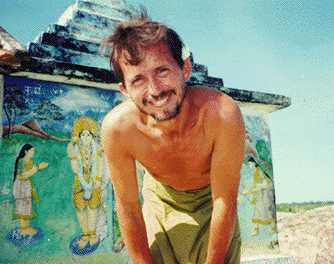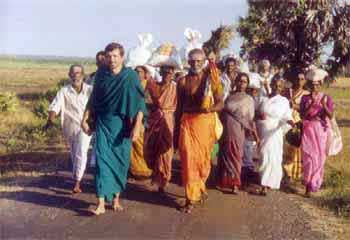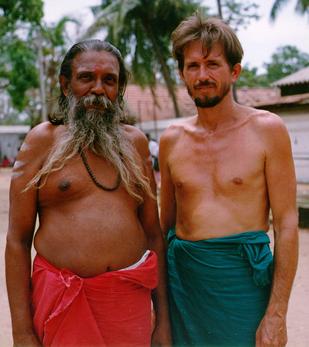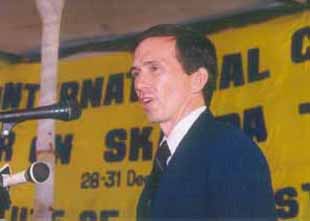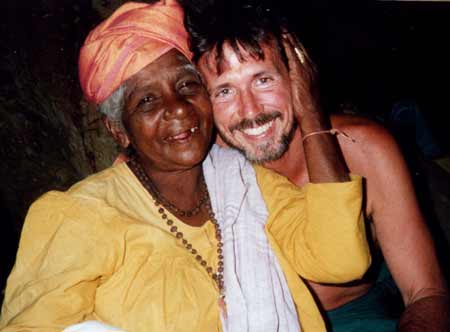|
| ||||||||||
Kataragama Deviyo's untiring white follower
By M. Nelson PiyaratneColombo: The Ceylon Daily News, Thursday 24, July 1997During the Esala festival period, Kataragama is a spiritual convention ground where one can meet and talk to swamis, faqirs and charismatic of every religious hue and persuasion. Buddhist, Hindu, Muslim and even Veddah devotees throng to Kataragama by the thousands from every corner of the island, and even an occasional foreign pilgrim from distant lands may be seen. In recent times, Kataragama has attracted foreign tourists film teams, and researchers who have helped to make Kataragama famous the world over, especially among scholars of sociology, anthropology and religion. Slowly but surely, Kataragama's secrets and legends have become the subject of systematic investigation, revealing Kataragama to be a place of even greater marvel and mystery than anyone - scholar or devotee - could ever express or even imagine. Among such foreign scholars, none has displayed more persistence and dedication than Patrick Harrigan, MA, a 46-year old American indologist and religious scholar who has made the Kataragama pada yatra and Esala festival the object of in-depth study since 1988. Not content with viewing Kataragama's colourful traditions from the sidelines like scholars of a more conventional mould, Harrigan has become deeply involved as a participant and has become an unabashed Kataragama devotee as well. For the past ten Esala festival seasons, Harrigan has been a familiar if not peculiar sight in Kataragama. Generally bare-bodied and barefoot in characteristic peacock-green pilgrim's dress, Harrigan may be seen at the mosque, at the Mahadevale, at Kiri Vehera or among the mostly-Tamil pada yatra pilgrims with a notebook and video camera at his side as he fraternises with anyone having a story to tell about mystic Kataragama. In fact, Harrigan has his own story to tell as this correspondent discovered, and it is a story no less strange than these of his devotee-informants. Harrigan attributes his attachment to Kataragama, so he says, to previous lifetimes spent in pursuit of Kataragama's wealth of traditional knowledge. "Who knows?" he wonders out loud, "I may have once been an apprentice kapurala or swami here who made one small mistake and as a result was reborn on the other side of the world with the task of finding my way back. Whatever it was, that karma is still working itself out. At least, I am happy to be here." Harrigan claims that even as a toddler in America, he used to wonder how he came to have a brand-new human body when he could not remember where it came from. "Even then, I was sure that I came from somewhere far away and my real home was there," he says. When the Russians launched their Sputnik series of satellites in the late 1950s. America reacted by calling for more students to study space science and engineering course. Harrigan turned to the study of astronomy and physics as the logical continuation of his personal quest to understand the nature of human existence. "But our present-day science does not possess the tools or techniques required to penetrate the ultimate mysteries. That tool, I learned, is the human body and mind itself, and the techniques have been studied and explored here in the Orient for thousands of years," says Harrigan. In 1970 as a third-year undergraduate at the University of Michigan, Harrigan decided to come to Asia to learn about Buddhism first-hand. He stayed for two months at a zen Buddhist monastery in South Korea where he shaved his head and donned the grey robes of a monastic novice and later visited Buddhist sites in Japan, Taiwan, Thailand, India and Nepal. "Finally as I was about to return to Michigan to report to my professors, I realized that I was learning far more on my own here in Asia than in any classroom there in America," he recalls. "So I decided to come to Ceylon where I could study and practice Buddhism properly as the Buddha himself had taught."
Harrigan was living as an upasaka at the Island Hermitage near Dodanduwa when a fellow American Buddhist, Alan Marlowe of San Francisco, invited him to visit a shrine in the jungle where Buddhists, Hindus, Muslims and Veddahs all worshipped together in perfect peace and harmony. "I had not even imagined that such a place existed," says Harrigan. "Just by visiting and worshipping in Kataragama once, a whole train of causes and effects was put into motion lasting a lifetime." Shortly thereafter, Malowe and Harrigan went to Jaffna to meet the renowned German Swami Gauribala who, like Harrigan, had come from Germany more than thirty years earlier to become Bhikku Nyanakhetto at the Island Hermitage but later met his guru Yogaswami of Nallur in Jaffna. "From 1948 to 1972, every year German Swami used to walk from Jaffna to Kataragama. He was the chief of the fire walkers for years. More than that, he was a true nyani and siddha of the Kataragama guru parampara," Harrigan recalls with obvious admiration. In 1972, Harrigan walked from Selva Sannithi Murugan Kovil north of Jaffna with German Swami and other devotees, including Bebi Swami Amma, 58, of Trincomalee who this year led the Kataragama pilgrims from Trinco on her 38th pada yatra. The experience left a lasting impression on young Harrigan, for though his travels and studies were to take him across much of Asia, Europe and America, he always yearned to walk once again in the pada yatra. German Swami's continuing study of Lanka's sacred geographical power sites such as Kataragama and Sigiriya suited young Harrigan, who joined a growing circle of admirers of German Swami and his `Mu research' as he liked to call it. Harrigan insists that his Kataragama research is only a continuation of the German Swami's work. "In academic terms, I became one of German Swami's research associates," says Harrigan. "But it is equally true that I accepted this extraordinary man as my guru or guide through life. I have never once regretted taking that big step. German Swami instructed young Harrigan to go back to America and get a solid grounding in Indian languages and religion. Eventually Harrigan went on to earn his master's degree in South Asia Studies from the University of Michigan only two weeks before German Swam's mahasamadhi in 1984. Thereafter he also studies Sanskrit, Tamil and Sinhala at Berkeley and Cornell universities as well before returning to Sri Lanka to remain in 1989. The Kataragama Devotees Trust (KDT) had just been formed in 1988 and Harrigan leaped at the chance to rejoin his old swami and swami-amma friends who were intent on walking to Kataragama even in the shadow of war in the North and East. As the KDT's pada yatra field representative, he had ample opportunities to apply his knowledge of Tamil, Sinhala and even Hindi when dealing with troops of the Indian Peace-Keeping Force (IPKF) in 1988 and 1989. This year was his consecutive tenth pada yatra since 1988.
Prayer Answered"Returning to Sri Lanka to walk in the pada yatra and serve as a KDT volunteer was the answer to my prayers," explains Harrigan. "I learned that almost everyone who goes to Kataragama is going to ask for the God's help, such as to cure a disease or to pass an examination or to obtain employment." "So I decided to ask the God to find work for me. Not work there in America but work here in Kataragama, with or without payment. And he has responded graciously, as you can see. Now I have enough work to keep me busy for a lifetime," says Harrigan, who collects no salary for his work but depends upon friends and family for support. Applying the skills he learned in America imaginatively, Harrigan became acting editor of the Kataragama Research and Publications Project, writing dozens of articles about Kataragama for local English newspapers and publishing the KDT's annual newsletter Bhakti in Sinhala, Tamil and English from 1990 to 1993. At the same time, his work with Sri Lanka's Cultural Survival Trust has made Harrigan one of very few Westerners to do fieldwork among both the Tamil-speaking and Sinhala-speaking Veddah communities of Sri Lanka. His work in Kataragama has also resulted in the creation of a traditional-style meditation ashram called Kataragama Kaele Kendra. Wily God
When asked about his experiences in Kataragama, Harrigan declines to give details. Instead, he repeats the well-known saying that "mehe Kataragame hungak rahas thiyenawa", that Kataragama is a place full of secrets. "I can say only this much," confides Harrigan, "The God has kindly taken me into His service. I am one of His many servants. He helps me and guides me in His own inscrutable way. I am simply one of His servants, one of His tools here on earth." And yet, having said this, Harrigan alleges that the multi-religious God of Kataragama is a wily rogue whose modus operandi is to stir mischief with the object of instilling wisdom and love in His devotees. "Whether you study the ancient Sanskrit texts or listen to the living oral traditions of modern Sri Lanka, the conclusion is the same," says Harrigan. "Kataragama Deviyo or Murugan or Kande Yaka or al-Khidr whatever you call him is a saintly rascal, a grandmaster of subterfuge and deception". "Like all devotees of the God, I assume that He exists or else I would not be doing this. I don't see Him, but I assume that He sees me, my deeds, and my very thoughts. I don't claim to understand Him, but I have immense respect for Him." "I know that it is a hopeless task, but I am hunting this wily god of hunters. I would like to interview Him for the newspapers, if He ever shows himself that is."
Although he may seem to be joking at the Kataragama god's expense, it is clear from meeting Harrigan that he is in dead earnest. He adds that he was 'excommunicated' from the closed world of American indologists for frankly expressing his views about the wily god of Kataragama. In America, it seems, respectable indologists do not believe in the gods that are their objects of study. Harrigan is not one of them.
What advice does scholar-devotee Harrigan have for Sri Lankans? He says: "From studying the patterns and listening to the swamis, one can say this. Suffering and injustice in this island have been building for years at the same time that the Kataragama god has gone into hiding, as it were." "This suggests to me that some big surprise is in the works, a big surprise for everyone. This is the lull before the storm, the deceptive appearance of inactivity before Kataragama lowers the boom. It won't happen here in Sri Lanka alone, but will sweep across the face of the earth overnight, as it were." "Speaking personally, when the surprise comes I want to be there to study it. I am convinced that this is part of a great change that humanity must pass through." In the meantime, Harrigan has expanded his operations to include South India. He is now attached as a doctoral student in religion to the Institute of Asian Studies in Madras where he is writing his dissertation on the cult of Kataragama-Skanda. And he has begun producing `Bhakti' video documentaries on a modest scale. "The next big event comes next year when our Institute in Madras hosts the First International Conference-Seminar on Skanda-Murugan," says Harrigan, adding that the god in his mysterious sense of humour saw fit to appoint Harrigan to the central organizing committee as its Secretary. "Needless to say, Kataragama will be well-represented," says Harrigan. "Dr. Aluthwewa Soratha Thera of Kirivehera will present a paper on Kataragama in Sinhala Folklore, while Dr. T. Senthilwel of Colombo will speak about mystical practices in Kataragama. Someone else will present a paper on traditions of Islamic Kataragama, and I will also see that Kataragama gets its share of international attention." Judging from the energetic efforts of this one American devotee, Kataragama is indeed likely to be an object of scholarly scrutiny for many years to come. 2002 interview with Patrick Harrigan
|
| Living Heritage Trust ©2023 All Rights Reserved |
